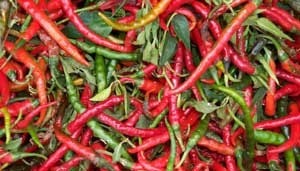
| Botanical Name: |
| Capsicum frutescens |
| Common names: |
| Cayenne, African Pepper, Devil's Tongue, Red Bird Pepper, Hot Flame, Cockspur Pepper and Goat's Pepper |
| Description: |
| Cayenne is a shrubby plant about 2 to 4 feet tall that is native to South and Central America. It is grown worldwide for it's culinary and medicinal properties. The plants have smooth, somewhat shiny, green leaves, and flowers that produce elongated oval-shaped pods (peppers) that contain dozens of tiny, pungent tasting seeds. Advertisement |
| Exposure: |
| full sun |
| Cultivation: |
| Cayenne can be successfully grown anywhere under the right conditions. It needs approximately 14-16 weeks to mature. Cooler climates should set transplants out as soon as the danger of frost has passed. Peppers prefer warm, evenly moist, nutrient-rich soil and warm temperatures. |
| Propagation: |
| seeds |
| Parts Used: |
| pod and seeds |
| Harvesting and Storage: |
| The longer the cayenne peppers remain on the plant, the redder they become. Don't be fooled though, green pods are just as hot. Remove and use fresh as needed. Whole peppers can be dried on the plants or removed and spread out in a warm, dark room. Store in an airtight container. |
| Medicinal Uses: |
| Capsaicin is the substance in cayenne peppers that makes them hot. Despite its 'burning' reputation, it has a soothing effect on the digestive tract and can aid in the treatment of other conditions including migraines, toothaches, fevers, congestion, sprains and muscle pain. Cayenne can also be applied topically to improve blood flow. High doses can be dangerous and lead to kidney damage, so cayenne, like all herbs, should not be used without consulting a physician. |
| Culinary Uses |
| adding heat and spice to foods |
| Other Uses: |
| wreaths or swags, kitchen decor |